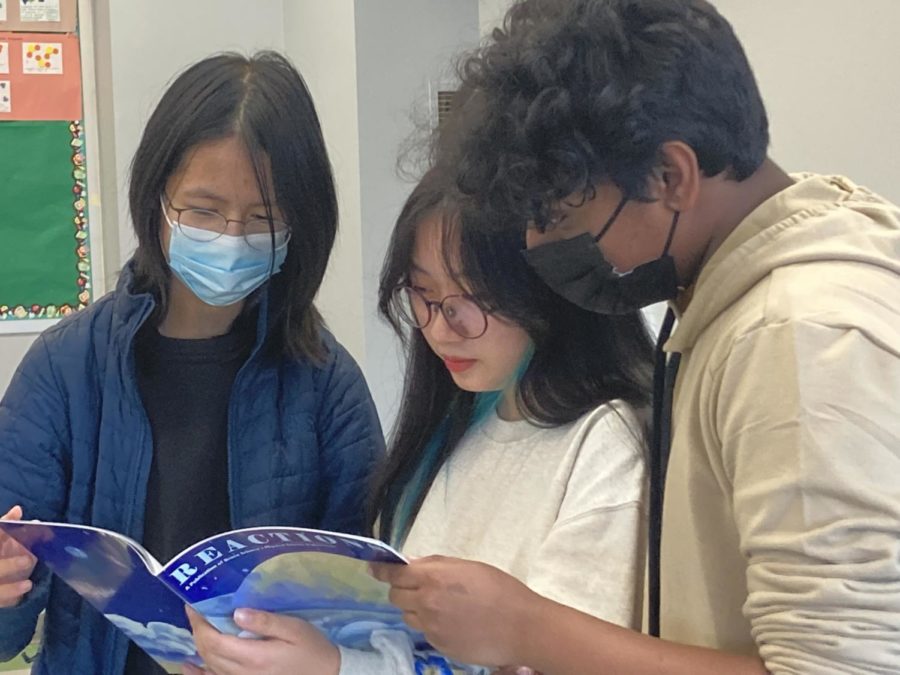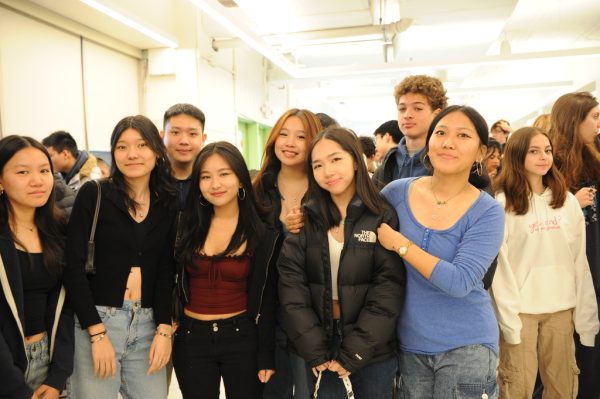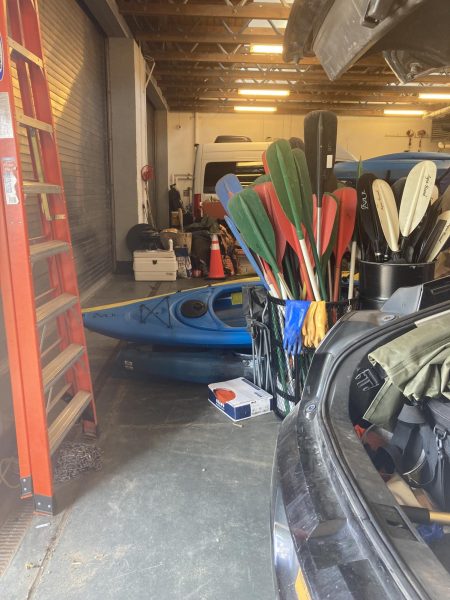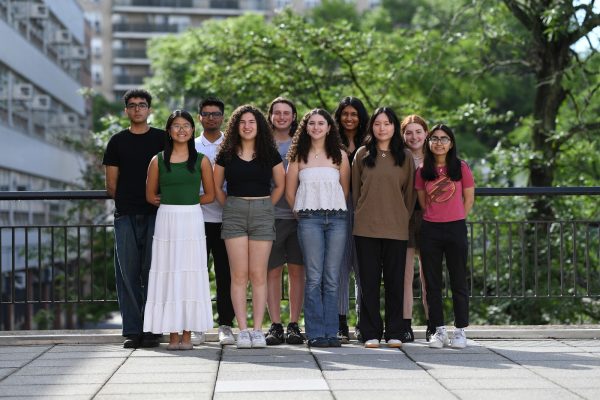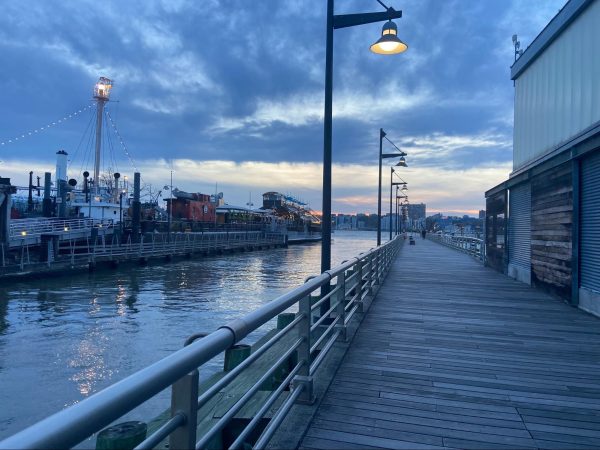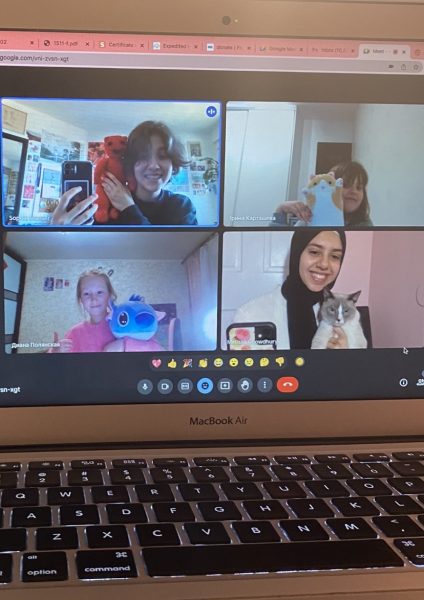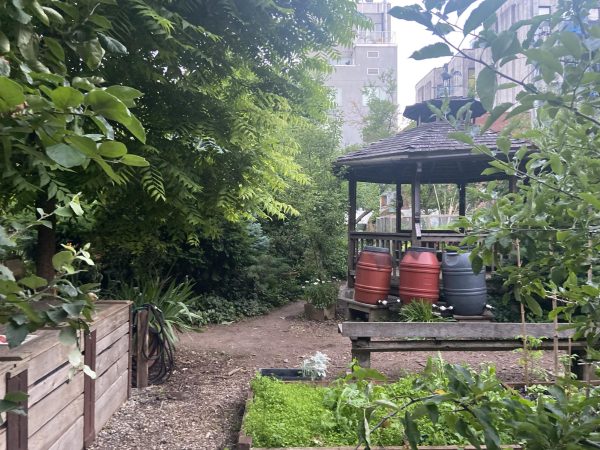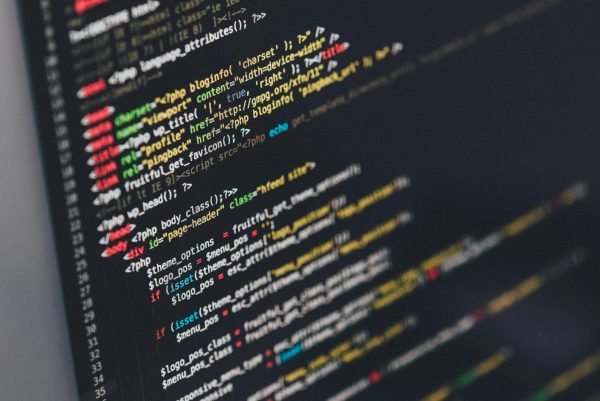A Profile of REACTIONS, Bronx Science’s Physical Science Journal
After years of meeting remotely due to the COVID-19 pandemic, the team behind the Bronx Science physical science magazine is working to adjust to in-person operations again.
Editor-in-Chief Julianne Lee ’23 shows new members of REACTIONS the 2022-2023 issue of the magazine.
In the Physical Science wing of The Bronx High School of Science, a bulletin board reads ‘Reactions,’ highlighting the school’s physical science journal of the same title. Illustrations of forces and rocket science decorate the display, reflecting the purpose of the magazine, to create intriguing articles about the physical sciences.
REACTIONS began with a group of students who wanted to create a platform for like-minded peers interested in researching and writing science articles. It serves as an outlet and resource, providing writers a chance to compose captivating works about topics that interest them and share news and facts about the scientific world with readers.
Annually, students create chemistry and physics-related articles, graphics, and puzzles for the publication. After crafting the finished magazine, the team sees to all aspects of the production of the journal including ad sales, printing, binding, and journal sales. From the creation of each year’s content to the distribution of the issue, a physical science department teacher serves as an advisor to oversee this process.
While experienced members from the previous year compose a majority of this year’s team, the 2022-2023 school year presents new complications for the new leadership.
For the past few years, REACTIONS has met completely remotely due to the COVID-19 pandemic, but the team is looking to shift to a hybrid meeting structure this year, incorporating in-person meetings.
For this to be possible, however, REACTIONS needed to find a new advisor, a role left vacant as the school year began in September 2022. Searches for a new advisor proved to be the board’s first challenge, as the ever-growing list of clubs left prospective teachers to be few and far between.
It was in early December 2022 that Julianne Lee ’23, the team’s Editor-in-Chief for the 2022-2023 school year, succeeded in finding a new advisor: Ms. Ghaffar, a Chemistry teacher at Bronx Science.
“I decided to become an advisor for the REACTIONS journal because I have always loved exploring research articles,” Ms. Ghaffar said. “Even though I have pursued my love for research a lot as an undergrad and grad student, I am still researching as I work on my doctorate degree. I believe that advising the REACTIONS journal will give me a different perspective on research as I review the wonderful articles written by the students. I cannot wait to see them putting together their amazing work!”
After finding an advisor, in-person REACTIONS meetings could finally commence, taking place every other Monday during 10th period.
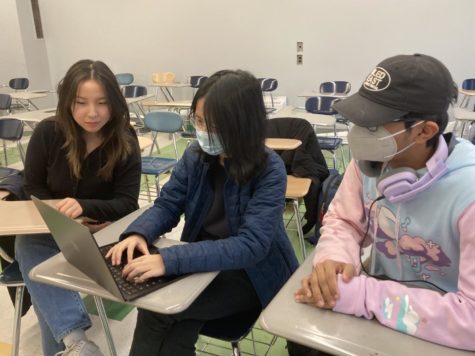
This, however, was not the end of the difficulties the team faced. A problem that still remained was recruiting more members and distributing the publication to the student body.
“Not a lot of students know that our school has a physical science journal and may be intimidated to join without any formal physics knowledge,” Lee said. “Since we ran the publication entirely online last year, communication and involvement were pretty difficult for our team.”
To prevent this issue from recurring, the team aims to increasingly publicize REACTIONS by spreading the word about the publication, which would, hopefully, catch the interest of more potential recruits for the journal.
The magazine had been running as a department publication unaffiliated with the League of Presidents (LOP). Recently, however, REACTIONS joined the over 100 clubs on the LOP club list. The team decided to enact this change to make the journal more accessible to students. When looking on the LOP club list, students who are looking to join STEM-related extracurriculars can find out about the journal, which may align with their interests and bring more writers onto the team. The team also plans on creating a promotional video to be aired on Wolverine TV, the school’s weekly news program, and hanging up posters around the school to spread the word.
Beyond just advertising the publication in school, the REACTIONS team looks to reach outside Bronx Science grounds. This includes posting more regularly on the journal’s Instagram account (@bxscireactions) and spreading the word about the publication in daily conversation.
With these plans in place, of the main problems the publication faced coming into the 2022-2023 school year, the question of how to distribute the finished 2022-2023 issue to the student body remains.
This year, Lee is working with the Bronx Science administration to allocate funds for ordering copies of the magazine. The REACTIONS team hopes to share the finished product with the student body by having more copies to distribute to interested students.
Besides the admittedly heavy workload to operate the publication, the team has set visions to improve the publication and streamline the processes behind the scenes.
“I think REACTIONS has a ways to go in terms of expanding, and hopefully we get a lot of new editors this year at meetings and through the submission system similar to publications like Math Bulletin,” Lee said.
Unlike other department publications at Bronx Science, like Math Bulletin, REACTIONS had not implemented a process in which students would submit articles to the team to review and edit. Instead, the team members in REACTIONS wrote all the articles themselves.
Since this resulted in past difficulties in terms of not having enough articles by the end of the school year, the team agreed to employ a different approach to acquiring articles: a submission form that any student at Bronx Science could fill out.
In addition to this new article submission system, the team seeks to fundamentally improve other aspects of the journal, including creating a space to share a plethora of voices from the science community, not just the loud ones. “I also hope to make ‘Physicist Spotlight’ a permanent section on the publication to continue to highlight the achievements of underrepresented physicists and show students role models they can identify with,” said Elaine Jiang ’23, a graphic designer for the 2022-2023 school year.
Jiang wrote an article on Asian American physicist Cheiun-Shiung Wu for the 2021-2022 issue, describing the experience as empowering. She said, “Although the article is different from our usual science-heavy articles, I thought it was important to highlight her story as a woman in physics. Researching to tell her story, it was resonating to learn everything from the sexism she faced to how she sought to strike a balance between stereotypical roles of being a mother and spouse and to frontier the field of experimental physics.”
The improvements do not just end here, however, as Lee seeks to expand REACTIONS online as well. The team had already agreed to create Instagram posts reminding others when the next meeting is, and in the same vein, Lee plans to open a Webmaster role in the team to develop a REACTIONS website.
“I think REACTIONS helped me develop as a writer by forcing me to appeal to a wider audience without compromising depth,” Lee said. “Especially when it comes to research, I’ve always been very technical in my writing, which is sometimes a barrier when you want to be understood. Probably my favorite part about being on the REACTIONS team is editing peer articles and seeing them evolve with each draft.”
This sense of collaboration fills the air during each meeting, fueling the publication and motivating the team to make the 2022-2023 edition the best one yet.
“I learned how to give constructive criticism, and how to know how people would respond and get my point across, as well as how to get the article to feel right,” said Zubair Almahmood ’23, the Editor of the team. Since joining the team during his junior year, he learned how to write articles palatable and fascinating to the average reader.
Though there are numerous obstacles to overcome for the publication to succeed this year, the REACTIONS team is determined to develop the journal to reach not just students at Bronx Science, but also others who are interested in physical science across the globe.
“I think REACTIONS helped me develop as a writer by forcing me to appeal to a wider audience without compromising depth,” Lee said. “Especially when it comes to research, I’ve always been very technical in my writing, which is sometimes a barrier when you want to be understood. Probably my favorite part about being on the REACTIONS team is editing peer articles and seeing them evolve with each draft.”
Katherine Han is a Copy Chief for ‘The Science Survey.’ She enjoys how journalistic writing serves as a channel of knowledge and medium for experimentation...

